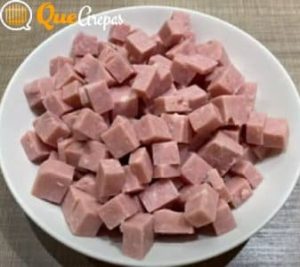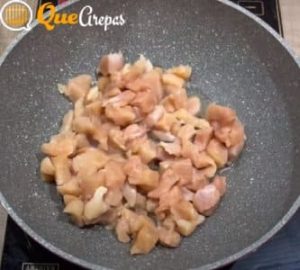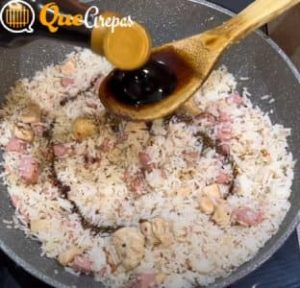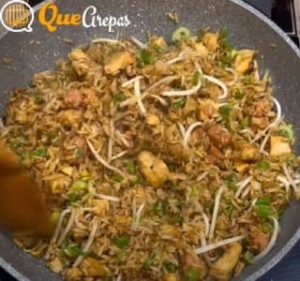Venezuelan Chinese Rice: A Delicious Encounter of Oriental and Creole Flavors
Immerse yourself in a gastronomic journey where Venezuelan tradition meets the flavors of the Far East. Venezuelan Chinese Rice is much more than a dish; it is a culinary experience that fuses two worlds in each delicious spoonful. Prepare your senses for a feast of unique flavors and irresistible textures.
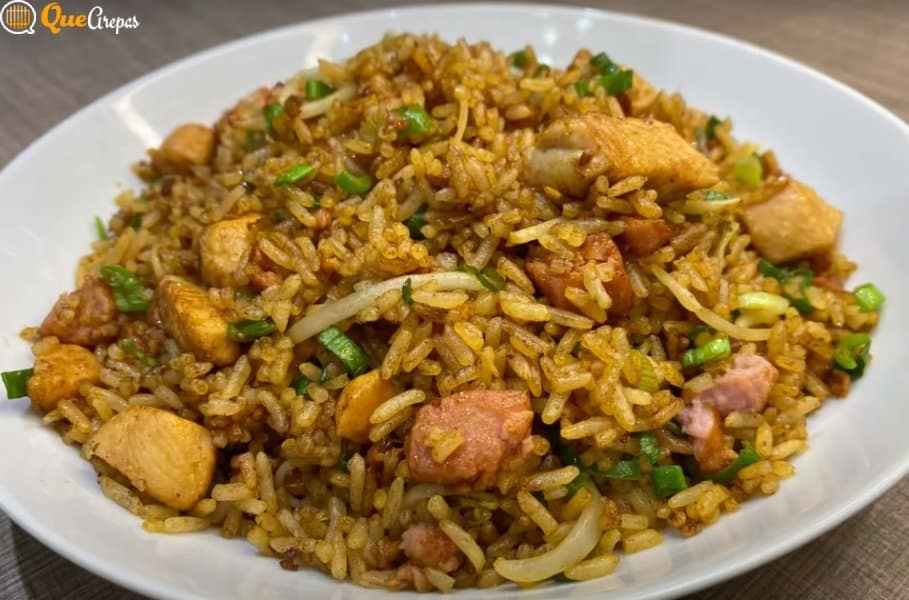
Aperitivos Venezolanos, Bollos Pelones, Tequeños, Patacones, Asado Negro, Pabellón Criollo
Venezuelan Chinese rice is a delicious culinary fusion that combines the best of Chinese and Venezuelan cuisine. This popular preparation has conquered the palate of many, becoming an emblematic dish of Venezuelan gastronomy. In this exquisite recipe, cooked white rice is combined with a variety of ingredients such as proteins, ham, chives and soy sauces, creating an explosion of flavors and textures.
The fascinating thing about Venezuelan Chinese rice is its versatility, as it adapts to different protein preferences. You can opt for juicy chicken, succulent shrimp, crispy bacon, tender beef or even add a combination of all of them. This allows you to customize the dish according to your tastes and create a unique culinary experience.
Discover the magic of this gastronomic fusion that captivates diners with its balance between oriental and creole. Immerse yourself in the world of Venezuelan Chinese rice and enjoy an explosion of flavors that will delight your senses.
- Preparation of Venezuelan Chinese Rice
- Additional ingredients to add flavor to Venezuelan Chinese Rice
- Sauces to enhance the flavor of Venezuelan Chinese Rice
- How to make Venezuelan Chinese rice step by step
- Venezuelan Chinese Rice Recipe - quearepas
- Secrets to Perfect Venezuelan Chinese Rice
- Creative Variants and Customization
- Presentation and Accompaniments
- Frequently Asked Questions
Preparation of Venezuelan Chinese Rice
Cooking the perfect white rice:
To obtain the ideal base for Venezuelan Chinese rice, it is essential to have cooked white rice with a loose texture and without lumps. Here are the steps to cook white rice the day before and achieve the perfect consistency:
- Rinse the rice: Wash the white rice under cold water to remove excess starch. Stir the cloudy water until the water runs clear.
- Ratio of water to rice: Use the proper ratio of water to rice. Generally, a 1:2 ratio is recommended, i.e., for every cup of rice, add two cups of water.
- Simmer: Place the rice and water in a suitable pot and bring to a boil. Then reduce the heat to low and cover the pot with a lid. Allow the rice to simmer for approximately 15-20 minutes, or according to package directions.
- Resting: Once the rice is cooked, remove the pot from the heat and let it rest covered for at least 10 minutes. This will allow the rice to absorb the steam and reach the desired texture.
- Cooling and refrigeration: After resting, transfer the rice to a bowl and allow it to cool completely. Then cover the container tightly and refrigerate the rice overnight. The refrigerated rice will acquire a firmer and more separated texture, perfect for Venezuelan Chinese rice.
Tips to ensure that the rice is loose and free of lumps:
- Use long grain rice: Long grain rice tends to be looser and less sticky, which is ideal for Venezuelan Chinese rice.
- Avoid stirring the rice while cooking: Stirring the rice during cooking can release starches and create lumps. It is better to let it stand without interfering.
- Fluffing: After refrigerating the rice, use a fork to loosen the grains and gently separate them before using it in the preparation of Venezuelan Chinese rice.
Protein selection and preparation:
Venezuelan Chinese rice offers several protein options to satisfy different tastes and preferences. Here are some popular options and instructions for marinating and cooking the chosen protein:
- Chicken: You can use chicken breasts cut into small pieces. Marinate them in a mixture of soy sauce, minced garlic and spices to taste. Then, sauté the chicken in a little oil until golden brown and cooked through.
- Shrimp: Use peeled and deveined shrimp. Marinate them in soy sauce, lime juice, garlic and a touch of ginger. Sauté shrimp in hot oil until pink and cooked.
- Bacon: Cut the bacon into small pieces and fry in a pan until crispy. Then, remove the excess fat and set aside to add as a delicious topping to the Venezuelan Chinese rice.
- Meat: You can use thinly sliced beef. Marinate it in soy sauce, garlic, pepper and a touch of brown sugar. Sauté the beef in hot oil until browned and tender.
You can combine different proteins according to your preferences and creativity. The preparation and cooking of the protein will add a delicious and complementary flavor to the Venezuelan Chinese rice.
Additional ingredients to add flavor to Venezuelan Chinese Rice
The touch of ham:
Ham is a key ingredient in Venezuelan Chinese rice, as it provides a characteristic and delicious flavor. Here are some tips for choosing and preparing the right ham, as well as suggestions for cutting it and combining it with other ingredients:
- Ham selection: Choose a good quality ham, preferably smoked or cured. You can choose between cooked ham, serrano ham or even smoked ham, according to your taste preferences.
- Preparation: Before using the ham in the Venezuelan Chinese rice, it is advisable to cut it into small pieces or cubes. This will allow it to be evenly distributed in the dish and mixed with the other ingredients.
- Combination with other ingredients: Ham combines wonderfully with different proteins, such as chicken, shrimp or beef. You can add them together in the same preparation, or you can use the ham as an additional complement to enhance the flavor of the rice.
- Topping: In addition to mixing the ham with the other ingredients, you can also use it as a topping for the Venezuelan Chinese rice. At the end of the preparation, sprinkle a few pieces of ham on top of the rice to add a crunchy and tasty touch.
The freshness of chives:
Scallion is an essential ingredient in Venezuelan Chinese rice, as it adds freshness, aroma and a unique touch of flavor. Here we present the importance of scallion in this recipe and creative ways to incorporate it:
- Importance of chives: Chives add vitality and freshness to Venezuelan Chinese rice. Its mild and delicate flavor perfectly complements the other ingredients, creating a harmony of flavors in the dish.
- Incorporation in the recipe: You can add the finely chopped chives during the final stage of the preparation of the Venezuelan Chinese rice. Mix the scallion with the cooked rice, proteins and other ingredients, making sure to distribute it evenly.
- Use as a garnish: You can also use the chives as a fresh and decorative garnish for the Venezuelan Chinese rice. Once you serve the dish, sprinkle some chopped chives on top to highlight its flavor and give it a visually appealing touch.
- Creative alternatives: If you want to experiment, you can try other ways to incorporate scallions into Venezuelan Chinese rice. For example, you can make a scallion sauce to accompany the dish or add thinly sliced scallions as an additional ingredient in the mix.
Sauces to enhance the flavor of Venezuelan Chinese Rice
Chinese dark soy sauce:
Dark soy sauce is a fundamental ingredient in the preparation of Venezuelan Chinese rice, as it provides a deep and salty umami flavor. Here is some information about this sauce and how to use it properly:
- Description of dark soy sauce: Chinese dark soy sauce is thicker and more concentrated than light soy sauce. It has a darker color and a more intense flavor due to its higher molasses content and prolonged fermentation. This sauce adds richness and depth to the flavor of Venezuelan Chinese rice.
- Amount and how to add: Dark soy sauce should be added sparingly to avoid overpowering the other ingredients. Start by adding a small amount and taste the flavor. If you want a more pronounced flavor, gradually add more dark soy sauce according to your personal preference.
- Even distribution: To ensure that the dark soy sauce is evenly mixed into the Venezuelan Chinese rice, pour it in while you are stir-frying the main ingredients in the wok. This will allow the soy sauce to distribute throughout the mixture and integrate with the other flavors.
Chinese light soy sauce:
Chinese light soy sauce is a milder and less salty variant of dark soy sauce. It is used to balance the flavor and add a touch of freshness to Venezuelan Chinese rice. Here are some recommendations for its use:
- Use of light soy sauce: Light soy sauce is ideal for those who prefer a milder and less intense flavor. It brings a salty touch and a note of freshness to Venezuelan Chinese rice without overpowering the other ingredients.
- Amount and timing: Add the light soy sauce at the end of the preparation of the Venezuelan Chinese rice, just before serving. Start with a small amount and adjust according to your personal taste. Remember that it is best to add gradually and taste the flavor to avoid the dish becoming too salty.
- Balancing flavors: The light soy sauce is used to balance the overall flavor of the Venezuelan Chinese rice. It adds a touch of freshness and enhances the natural flavors of the ingredients, without overshadowing them.
How to make Venezuelan Chinese rice step by step
To make a Venezuelan Chinese Rice in an easy way and get a delicious result, we just need to follow this recipe carefully and accurately. Thanks to CocinaconelChino7747 and his channel.
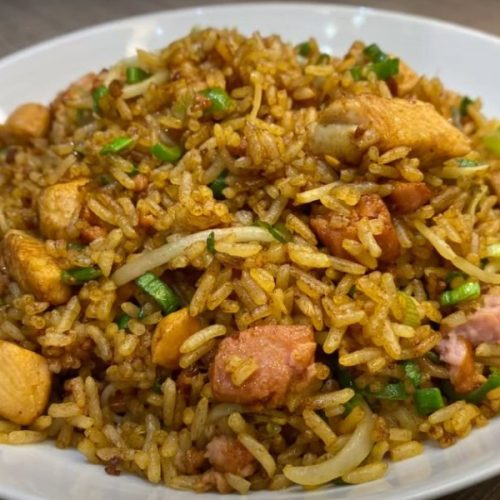
Venezuelan Chinese Rice Recipe - quearepas
Ingredients
- 1 kg Unsalted white rice (best if cooked one day in advance)
- 2 unit Chicken breasts (You can also use any other type of protein, shrimp, bacon, beef, egg).
- 1/2 kg Ham
- 6 unit Chive Bunches
- 250 gr Chinese sprouts or dragon's tooth.
- 1 tbsp Salt to taste
- 1/2 tbsp Sugar
- 1 unit Chinese dark soy sauce
- 1 unit Chinese light soy sauce
Instructions
Sautéing of the ingredients:
- Preparation of ingredients: Make sure you have all the ingredients chopped and ready before you begin. This includes the protein (chicken, beef or shrimp), ham and chives, as well as any additional ingredients you wish to add.
- Heating the wok or frying pan: Heat the wok or frying pan over high heat and add a little vegetable oil. Make sure the wok is very hot before you start stir-frying the ingredients.
- Sautéing the protein: Start by sautéing the protein, such as chicken, beef or shrimp. Cook until golden brown and almost fully cooked. Remove the protein from the wok and set aside.
- Sautéing the ham and scallions: Add the ham and sauté for a few minutes until lightly browned. Then add the scallions and continue sautéing until tender but still crisp. The ham and scallions should blend and complement each other.
- Return the protein to the wok: Add the previously cooked protein back to the wok along with the ham and scallions. Mix well so that all the flavors combine.
The magic of the final combination:
- Adding the cooked rice: Add the cooked rice to the wok with the sautéed ingredients. Make sure the rice is cool or at least at room temperature. This will help prevent it from becoming sticky during cooking.
- Even mixing: Mix the rice gently but steadily, making sure that all ingredients are evenly distributed. This will ensure that each bite has a balance of flavors.
- Adjust seasoning: Taste the Venezuelan Chinese rice and adjust the seasoning as needed. You can add more dark or light soy sauce, salt, pepper or other seasonings of your choice. Remember to do this gradually, tasting the flavor after each addition.
- Balance of flavors: Pay attention to the balance of flavors in Venezuelan Chinese rice. Make sure that the main ingredients, such as protein and ham, are not overshadowed by the seasonings. The flavors should complement and enhance each other.
Video
Notes
Nutritional Information
Nutritional information may vary depending on the amounts and types of ingredients used in the recipe, as well as the serving size. Below is a general estimate of the nutritional information for a typical serving of Venezuelan Chinese Rice: Serving Size: 1 serving (approximately 200 g) Calories: Around 350-400 kcal Fats: 8-10 g- Saturated fats: 2-3 g
- Trans fats: 0 g
- Dietary fiber: 2-4 g
- Sugars: 1-2 g
Secrets to Perfect Venezuelan Chinese Rice
The Art of Cooking Rice to the Ideal Texture
Rice is the heart of this recipe, and getting the right texture is critical. Use rice cooked a day ahead, refrigerated. This prevents it from becoming sticky during stir-frying. When heating it in the wok, distribute the grains gently to avoid clumping. The result should be a loose, slightly crunchy rice that absorbs flavors without becoming mushy.
Wok Sauteing Techniques
The wok is the essential tool in this preparation. Heat it well before adding the ingredients. Start with the protein and ham, making sure they cook evenly and color. Push the ingredients to the sides of the wok and add the rice to the center. This allows the rice to come in direct contact with the heat, enhancing its flavor and texture. With quick, steady movements, stir-fry everything so that the flavors blend without overcooking.
Enhancing Flavor with Times and Temperatures
Balance of flavors is key. Add dark and light soy sauces gradually to prevent the dish from becoming too salty. Control temperatures: the wok should be hot enough to cook quickly without making the ingredients soggy. Adding scallions and Chinese sprouts at the end keeps them fresh. With precise timing and proper temperature, each component contributes to a harmonious and authentic flavor.
Creative Variants and Customization
Exploring Protein Options
The versatility of Venezuelan Chinese Rice allows you to adapt it according to your preferences. Instead of chicken breasts, you can opt for juicy shrimp to add a marine touch. Bacon, with its smoky flavor, offers a different dimension, while beef adds robustness. Scrambled eggs add smoothness and richness, completing the flavor palette.
Adding Extra Ingredients
Creativity knows no bounds when it comes to additional ingredients. Integrate a variety of fresh vegetables such as peppers, carrots and peas to add color and texture. Dried fruits, such as walnuts or almonds, add a delicious crunch and distinctive flavor. These extra ingredients blend harmoniously with the rice, creating a visual and gustatory feast.
Adapting the Recipe to Personal Preferences
The beauty of Venezuelan Chinese Rice lies in its ability to adapt to your tastes. If you prefer a spicier touch, add a little chili or hot sauce. If you're looking for a healthier profile, opt for brown rice instead of white. Experiment with different proportions of soy sauces to adjust the intensity of the umami flavors. The power is in your hands to create a unique dish that reflects your style and preferences.
Presentation and Accompaniments
Serving with Style: Plate Presentation Tips
The presentation of Venezuelan Chinese Rice not only highlights its appetizing appearance, but also anticipates a memorable experience. Use large plates that allow the colors and texture of the dish to be appreciated. Form a mound of rice in the center and arrange the protein, ham and vegetables around it. Garnish with chopped scallions and Chinese sprouts for a fresh and vibrant touch.
Traditional Venezuelan Complements
Elevating the culinary experience is possible by adding traditional complements. Accompany your Venezuelan Chinese Rice with golden and crunchy arepas, which contrast perfectly with the softness of the dish. Sliced avocado adds creaminess and freshness. And don't forget a portion of fried ripe plantains to add a sweet and sour touch that characterizes Venezuelan cuisine.
Suggested Food Pairing: Flavor Enhancing Beverages
The choice of beverages can enrich the dining experience. A Venezuelan Chinese Rice tastes even better when paired with refreshing and flavorful beverages. Opt for a light beer or a dry white wine, whose notes will complement the umami flavors of the dish. For the non-alcoholic, a lemonade with mint will add a refreshing citrus note that will bring out the flavors.
Keep enjoying more Venezuelan food recipes, especially Venezuelan arepas.
Frequently Asked Questions
What makes Venezuelan Chinese Rice different from traditional Chinese rice?
Venezuelan Chinese Rice is a unique fusion of Chinese and Venezuelan flavors. It combines traditional Chinese ingredients, such as fried rice and soy sauces, with Venezuelan elements such as ham and scallions, creating a distinctive culinary experience.
Can I use proteins other than chicken breasts?
Of course! Venezuelan Chinese Rice is highly customizable. You can opt for shrimp, bacon, beef or even egg as protein alternatives. Each choice will add a unique touch of flavor.
What are dark and light soy sauces and can I use only one of them?
Dark and light soy sauces are essential condiments in Asian cuisine. Dark soy sauce is thicker and has a stronger flavor, while light soy sauce is less intense. You can use just one of them if you prefer a more subtle flavor, but combining them usually provides a more complex balance of flavors.
How do I achieve the perfect texture of the rice in this dish?
Using pre-cooked and refrigerated rice is key to prevent it from becoming sticky. Heat it in the wok and be sure to distribute the grains evenly. The result should be loose and slightly crispy rice.
If you want to know other articles similar to Venezuelan Chinese Rice: A Delicious Encounter of Oriental and Creole Flavors you can visit the category Comida Venezolana.

